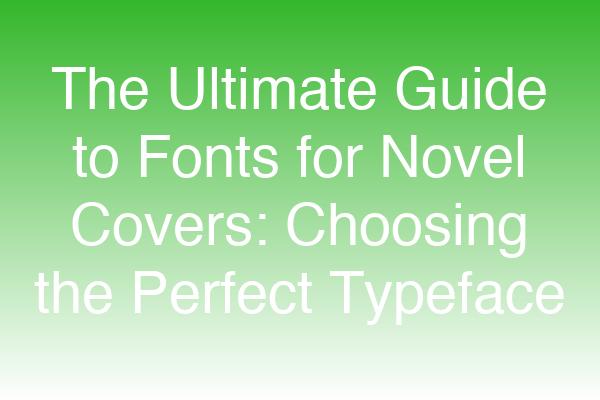
Introduction
In the world of publishing, first impressions matter immensely. The cover of your novel is often the first interaction a potential reader has with your story, and the font you choose plays a crucial role in that impression. Fonts for novel covers can convey the genre, tone, and mood of your book, making it essential to select the right typeface. In this guide, we’ll explore the best fonts for novel covers, tips for choosing the perfect typeface, and current trends that can help your book stand out on the shelf.
Why Fonts Matter in Book Design
Fonts are more than just letters on a page; they are a visual representation of your story. The right font can evoke emotions, suggest themes, and even attract your target audience. For instance, a whimsical font might be perfect for a children’s book, while a bold serif typeface could suit a gripping thriller. Understanding the psychology behind fonts can significantly impact your book's marketability.
Key Considerations When Choosing Fonts for Novel Covers
Genre Appropriateness: Different genres have established conventions. For example, romance novels often use elegant scripts, while science fiction might lean towards modern, sans-serif fonts. Researching popular books in your genre can provide insight into effective font choices.
Readability: While artistic fonts can be visually appealing, they must also be legible. Ensure that your title and author name are easy to read, even at a distance. Avoid overly intricate designs that may confuse potential readers.
Contrast and Color: The color of your font should complement the background of your cover. High contrast between text and background enhances readability. Consider using color psychology to evoke specific feelings related to your book's theme.
Top Fonts for Novel Covers
Here are some popular fonts that have proven effective for novel covers across various genres:
1. Garamond
A classic serif font, Garamond is known for its elegance and readability. It’s a great choice for literary fiction and historical novels.
2. Baskerville
This serif font exudes sophistication and is often used for romance and drama genres. Its high contrast between thick and thin strokes makes it visually appealing.
3. Futura
A geometric sans-serif font, Futura is modern and clean, making it ideal for science fiction and contemporary fiction covers.
4. Playfair Display
With its stylish curves and high contrast, Playfair Display works well for both romance and fantasy genres, adding a touch of elegance.
5. Montserrat
This sans-serif font is versatile and modern, suitable for a wide range of genres, from thrillers to young adult fiction.
Current Trends in Fonts for Novel Covers
Staying updated with design trends can give your novel a contemporary edge. Here are a few trends to consider:
1. Minimalism
Less is often more. Minimalist designs with simple fonts and plenty of white space are gaining popularity, allowing the title to take center stage.
2. Handwritten Fonts
These fonts add a personal touch and are particularly effective for memoirs or self-help books, creating a sense of intimacy with the reader.
3. Bold Typography
Using oversized, bold fonts can create a striking visual impact, drawing attention to your cover in a crowded market.
Common Questions About Fonts for Novel Covers
What are the best free resources for fonts?
Websites like Google Fonts, DaFont, and FontSquirrel offer a plethora of free fonts that can be used for novel covers. Always check the licensing agreements to ensure compliance.
How many fonts should I use on my cover?
Generally, it’s best to stick to two fonts: one for the title and another for the author’s name or subtitle. This maintains a clean and cohesive look.
Can I use a font from a popular brand?
Using a font associated with a brand can lead to legal issues. Always opt for fonts that are free for commercial use or purchase a license for premium fonts.
Conclusion
Choosing the right fonts for novel covers is a vital step in the publishing process that can significantly influence your book's success. By considering genre, readability, and current design trends, you can create a cover that not only attracts readers but also accurately represents your story. Remember, your cover is your book's first impression—make it count!
Call to Action
Ready to design your novel cover? Explore various fonts and start experimenting with different combinations today! Share your favorite fonts or cover designs in the comments below, and let’s inspire each other in the creative process.
By following these guidelines, you can ensure that your blog post on "fonts for novel covers" is not only informative and engaging but also optimized for search engines, helping you reach a wider audience.